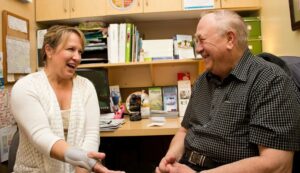Don Kupina isn’t ashamed to admit that he’s an addict. It’s an addiction he’s been struggling with for most of his life.
“If I was a drug addict, I would stop taking drugs and that’s it. If I was a smoker, I would stop smoking. If I was a drinker, I would stop drinking. But I’m a food addict. You can’t stop food. It’s a good addiction. It keeps us alive but it also plays its number in diabetes,” says Don, who has been a diabetic for the last 15 years.
He adds that all cultures celebrate and socializes with food. As a result, people can overeat at these events.
He credits Edmonton Southside Primary Care Network for providing services for the last 10 years that have helped him manage his diabetes.
“I’m very cognizant of the fact that the PCN has helped me so much and I thank the (health) system very much. It has created something that works so well at the frontline services,” says Don.
The frontline service he is referring to is the primary care nurse he sees at Meadowbrook Medical Clinic.
“I think it’s one of the greatest benefits you could have – that your frontline worker is an absolute specialist in the field you are dealing with. It’s very good to have a good doctor and that doctor is working with you. But doctors are under such stress and under time constraints that they don’t have sufficient time to spend with you on all of the intricate details that a patient needs to know,” he explains.
Don meets with his primary care nurse, Elaine St. Laurent, every 90 days to monitor his diabetes. Elaine reports back to his doctor, Dr. Narpinder Hans, if there are any issues.
Over the years, he’s learned lessons from the primary care nurses and dietitians, especially around his addiction.
“They made me realize if you don’t cut back on eating and you don’t have methods of metabolizing – one of them is pharmaceuticals and the other is exercise – then you are going to go down that road that is self-destructive with diabetes,” says Don.
“What the people of the PCN have taught me is if you really have that craving and you really have to have that candy or cookie, have it. Only one. Then don’t have it for another month. But you’ve got to get rid of that craving. If you don’t get rid of the craving, you will eat everything else around that cookie except that cookie.”
He’s also puts the responsibility of his own health back on himself and has seen an example in his own family where members have died from not caring for their health.
In the meantime, he makes sure he only puts two perogies on his plate instead of 36.
